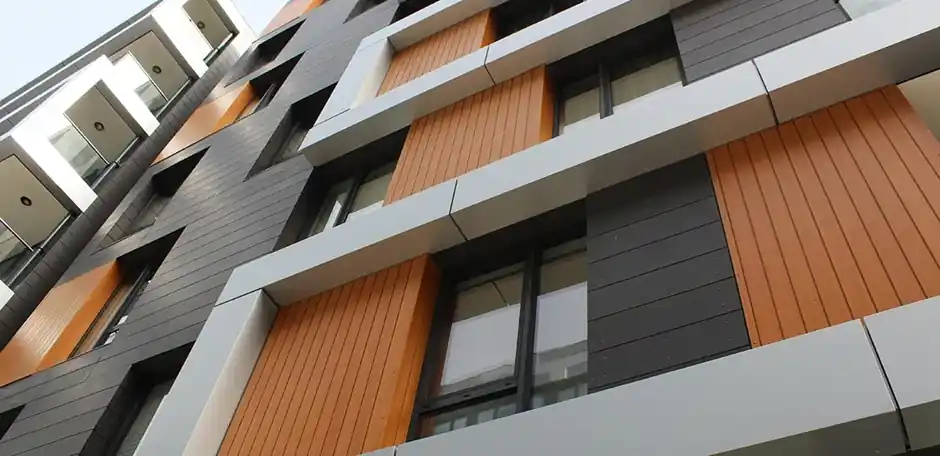
A comprehensive guide to types of rainscreen cladding and their structures
2024/11/24Rainscreen façades, as one of the modern façade systems in construction, play a crucial role in enhancing the performance and aesthetics of buildings. Known as ventilated façades, rainscreens are systems where the outer façade layer is separated from the building’s thermal and waterproof insulation layer, creating a space for air circulation between the two. This air gap acts as a barrier against rainwater infiltration into the building and prevents moisture and damage to the building’s infrastructure. In this article, we aim to examine various types of rainscreen façades, their structures, materials used, benefits, key points in design and installation, and compare them with other façade systems. Considering the growing importance of energy efficiency and building durability, a thorough understanding of rainscreen façades and their advantages can significantly help in choosing the best option for a building’s façade.

Main Types of Rainscreen Façades
Rainscreen façades can be classified into three main types based on rainwater management and structural details:
Open-Joint Rainscreen Façades
In this type, there are gaps between the panels that allow rainwater to pass through and drain away from the building. Due to its simplicity in installation and variety of materials, this type is widely used.
Closed-Joint Rainscreen Façades
Here, the gaps between the panels are completely sealed, and rainwater is only drained through designated holes at the bottom of each panel. This type provides a more unified appearance and is highly resistant to water infiltration.
Hybrid Rainscreen Façades
This type combines features of the previous two, with some joints open and others sealed. Hybrid rainscreens offer designers the flexibility to create diverse and complex designs.

Main Structure of Rainscreen Façades
All types of rainscreen façades generally consist of several key layers, each playing an important role in the system’s performance. The structure of a rainscreen façade is as follows:
- Outer Layer (Main Cladding):
This is the visible part of the building’s exterior, consisting of panels made from various materials such as metal, stone, wood, ceramic, etc. These panels protect against weather elements and contribute to the building’s aesthetic appeal. - Ventilation Cavity:
A gap between the outer layer and the insulation layer that acts as an air channel. This space helps air circulation and prevents moisture buildup and damage to the underlying layers. - Insulation Layer:
This layer provides thermal and acoustic insulation for the building. Insulating materials such as rock wool, polystyrene, and fiberglass are commonly used in this section. - Weather-Resistant Barrier:
This layer prevents water infiltration into the building and acts as a protective barrier. It typically uses an impermeable membrane for this purpose. - Substructure and Fasteners:
Proper substructure and strong fasteners are crucial for the durability and performance of the rainscreen façade. This section includes support structures, panel attachment systems, and drainage systems.
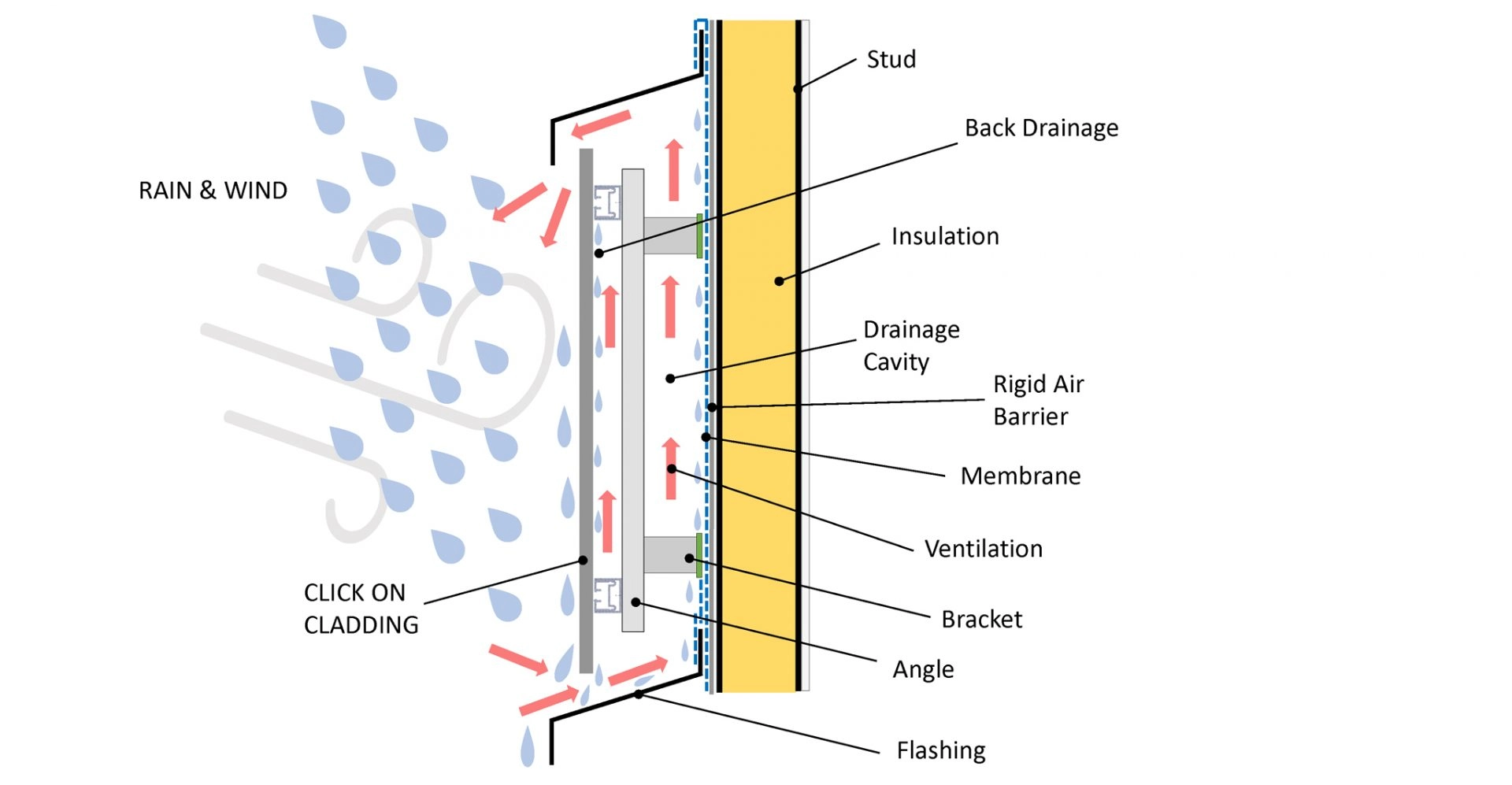
Common Materials Used in Rainscreen Façades
Choosing the right materials for various types of rainscreen façades has a direct impact on the building’s appearance, durability, and performance. Some of the most common materials used in rainscreen façades include:
- Metals:
Metals such as aluminum and steel are highly popular due to their high resistance to corrosion, lightweight, and excellent formability. These materials are available in a variety of colors and designs, offering a modern and minimalist appearance to the building.

- Ceramics and Stone:
Ceramics and natural stones such as granite, marble, and travertine provide a luxurious and classic appearance to the building. These materials are resistant to heat and abrasion, offering high durability and long lifespan.
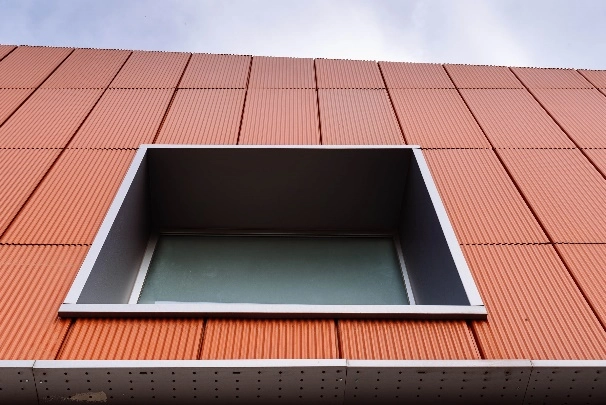
- Composites:
Composites are combinations of various materials such as resin and fibers. Due to their lightweight, high impact resistance, and variety of colors and designs, they are an ideal choice for rainscreen façades.
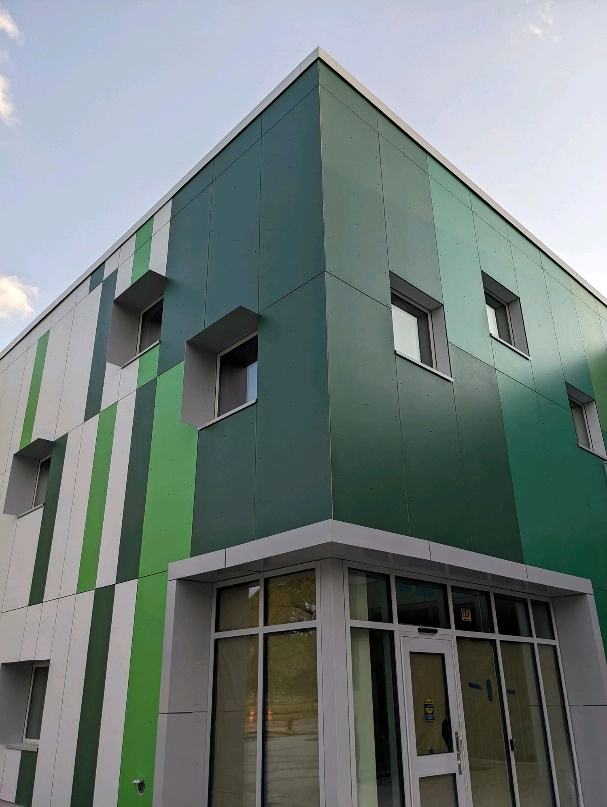
- Wood and Thermowood:
Wood and thermowood provide a natural and warm appearance, creating a sense of calm and intimacy in the space. Thermowood is a modified wood that has enhanced resistance to moisture, decay, and insects.
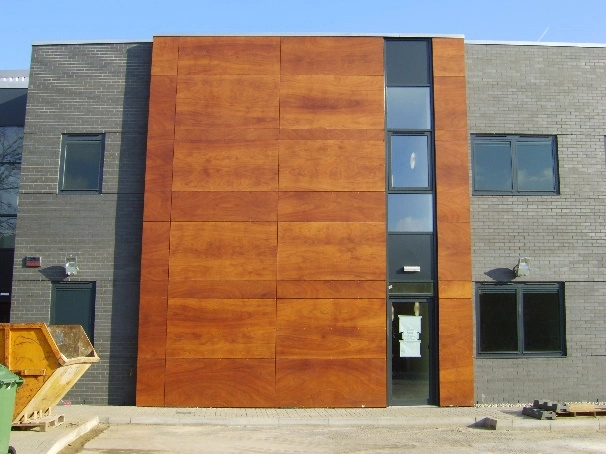
Advantages of Using Rainscreen Façades
Rainscreen façades have become one of the most popular façade systems in modern building construction due to their numerous benefits. Some of the key advantages of rainscreen façades include:
- Better Thermal Performance:
The ventilation cavity behind the cladding panels acts as a thermal insulator, preventing energy loss during both hot and cold seasons. - Water Infiltration Resistance:
The efficient drainage system in rainscreen façades prevents water from penetrating the building, reducing the risk of moisture damage and structural harm. - Increased Durability and Longevity:
By separating the outer layer from the underlying layers, thermal and moisture stresses are avoided, which extends the building’s lifespan. - Aesthetic Appeal and Design Versatility:
The wide variety of materials and colors available for rainscreen façades allows for the implementation of diverse and beautiful architectural designs.
Important Considerations in the Design and Installation of Rainscreen Façades
Successful implementation of various rainscreen façades requires attention to detail and adherence to technical standards. Some of the key considerations in the design and installation of rainscreen façades include:
- Wind Load Calculations:
Accurate wind load calculations and the design of the supporting structure are essential to ensure the façade’s resistance to wind pressure. - Execution Details at Critical Points:
Joints, corners, and connections are critical points in a rainscreen façade that require careful attention. Using proper sealing materials and executing precise details prevent water and air infiltration into the building. - Installation and Connection Methods:
Choosing the appropriate method for installing panels and connecting them to the substructure directly impacts the façade’s durability and performance. Various methods, such as screws and plugs, adhesives, and mechanical systems, exist, with the choice depending on the materials and building conditions.
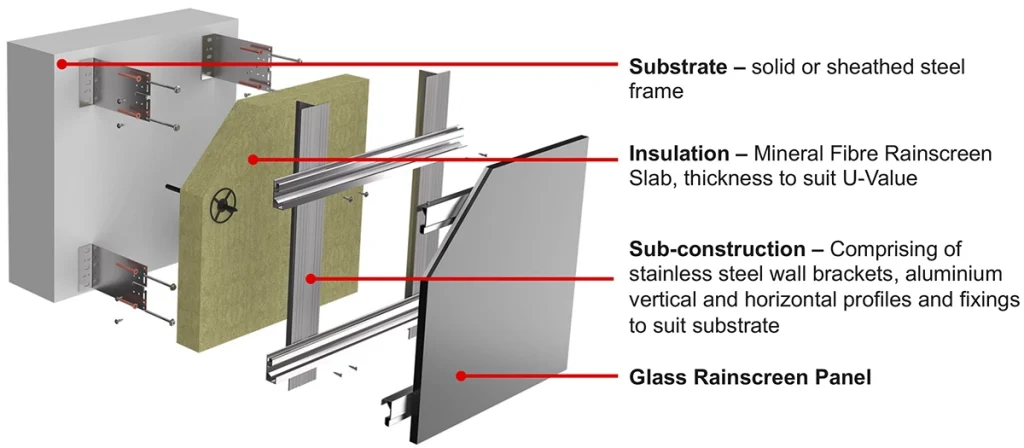
Comparison of Rainscreen Façade with Other Façade Systems
Rainscreen façades, with their protective outer layer and ventilated cavity behind it, offer significant advantages over other façade systems. This system, utilizing an outer layer made from various materials such as metal, stone, wood, or composite, protects the building from weather elements. The ventilation cavity behind the layer acts as both thermal and acoustic insulation and prevents moisture from entering the building.
- Comparison with Traditional Brick or Stone Facades:
Rainscreen façades are lighter, quicker to install, and provide better thermal and acoustic insulation compared to traditional brick or stone façades. Additionally, the design flexibility in rainscreen façades is much greater. - Comparison with Composite Façades:
While composite façades may offer benefits, rainscreen façades, due to the ventilation cavity, perform better thermally and acoustically.
In general, due to their numerous advantages, such as high durability, insulation properties, design versatility, and the option to use various materials, rainscreen façades are an excellent choice for modern buildings with diverse uses.
Final Words
Rainscreen façades, with their multi-layered structural system and ventilated cavity behind the outer layer, offer numerous benefits for buildings. These systems not only enhance aesthetic appeal and design versatility but also improve the thermal and acoustic insulation of the building. Given the many advantages of these modern and efficient façades, they have become one of the most popular choices for contemporary buildings. The selection of materials and installation methods for these façades depends on various factors such as budget, building use, climatic conditions, and personal preferences. It can be said that rainscreen façades, offering a comprehensive and efficient solution for façade design and installation, are a smart choice for today’s buildings.
References:
https://us.sfs.com/learn-more/rainscreen-cladding-materials
https://www.cupapizarras.com/int/news/what-is-rainscreen-cladding-advantages

